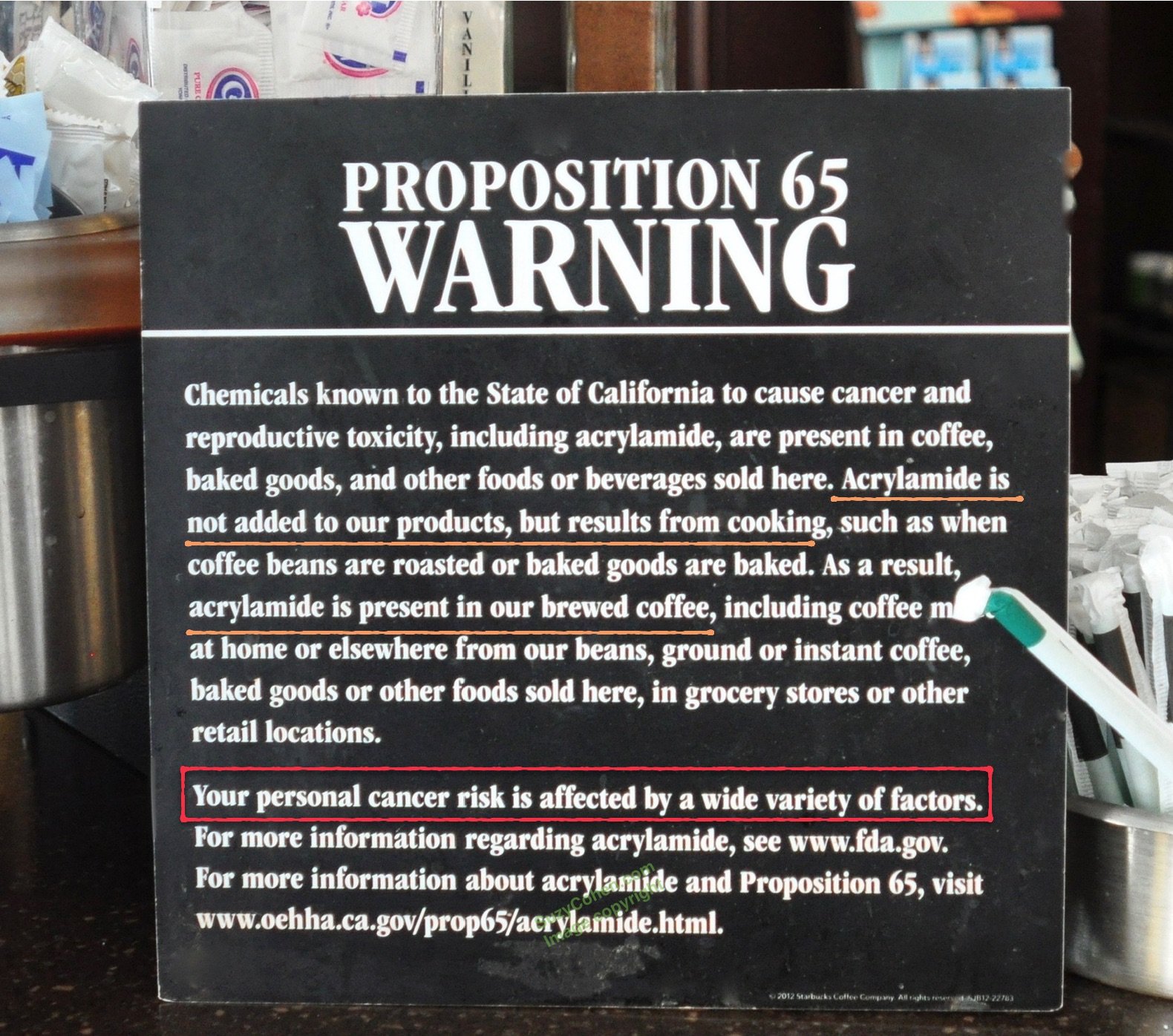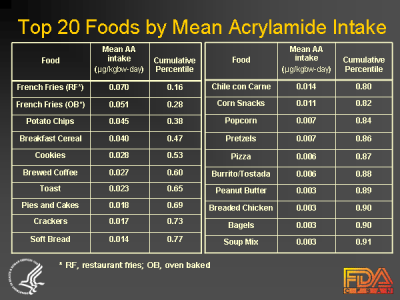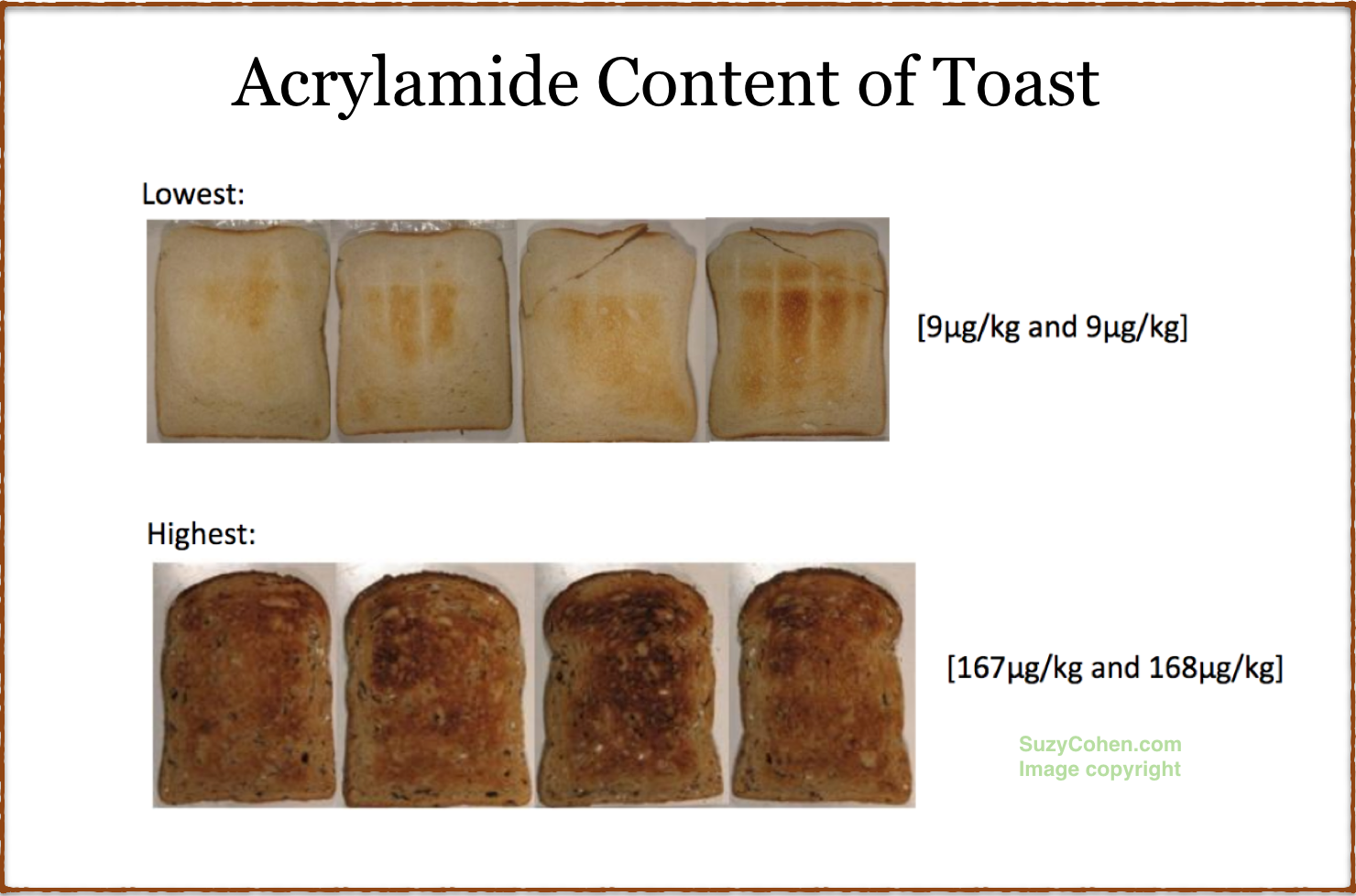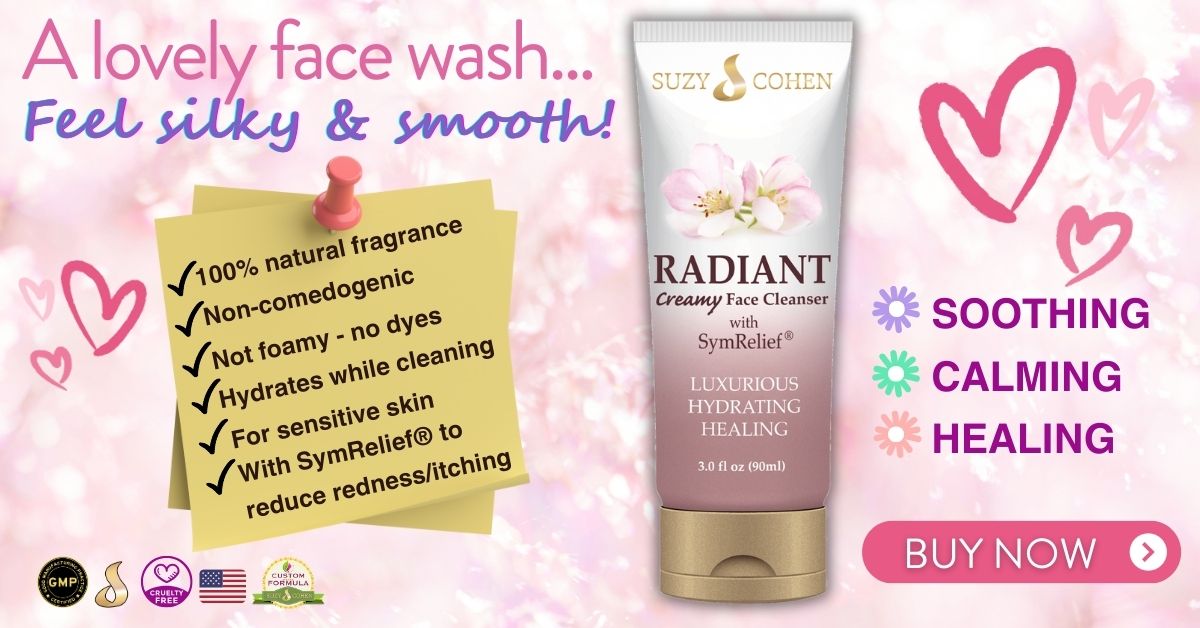When I think of acrylic, my mind goes to nail salons where they apply hard acrylic to your fingernails…it doesn’t go to coffee or potato chips! But this compound is, in fact, almost always present in coffee and potato chips, as well as many other foods such as cereal, French fries, peanut butter… even prune juice. Acrylamide levels are higher in things that are fried like French fries. Just like frying, toasting can produce acrylamide that’s why dark toast is worse for you than light toast, as are well-down has browns, versus lightly browned ones… basically the darker (more cooked) areas on your food tend to have more acrylamide. Coffee is high in acrylamide and that’s why coffee shops are facing scrutiny now.
I’ll circle back to this later and give you a basic list of foods that acrylamide is found in. For sure, smokers have very high acrylamide levels, about 50% higher than non-smokers.
Acrylamide or “acrylic amide” is now making national headlines because Starbucks and other big-name cafes are under fire. You see, acrylamide is a compound known to the FDA as a “possible” carcinogen. Carcinogens are things that cause cancer. This distinction given to acrylamide is important because we live in a world where cancer is the second leading cause of death. Reducing the burden of carcinogens in our body is critical to reducing personal risk for cancer.
To be fair, the carcinogenic potential of dietary-related acrylamide from foods and beverages is actually unknown. But this is all rising to the surface because of a case in California where acrylamide content in coffee was brought to the attention of The State. First you should know that acrylamides naturally occur in foods, and are particularly high in roasted foods. This compound forms when you cook certain foods, it’s not like an additive such as MSG or food coloring. It’s happening naturally as part of the food-making procedure.
Natural coffee beans don’t have acrylamide, it forms during the refinement process. When coffee growers roast their coffee beans, the acrylamide content goes up to a certain degree. Then coffee houses prepare beverages for us (the consumer) and we drink it. Does that mean we’re drinking acrylamide? I’m not so sure. It won’t stop me either, I’m planning to keep drinking it because well… I’m pretty ‘clean’ otherwise in terms of chemicals and toxins (you would be impressed) and also, I’m neurotic enough, lol! I’m not giving up coffee! Studies show it can help prevent certain cancers and keep your brain functioning at a high level. But this is still very interesting, and you need to understand it.
Since cafes are using roasted coffee beans, the potential for acrylamide exposure to you (the consumer who drinks it) places a question mark in terms of your carcinogenic load. Remember, minimizing “possible carcinogens” is key to reducing risk. In recent breaking news, Superior Court Judge Elihu Berle has just ruled that coffee companies like Starbucks, Peet’s and others will have to post a cancer warning, at least in the state of California.
The whole problem for coffee makers began when a nonprofit case that was initiated stating that businesses (with at least 10 employees) that sold coffee were in violation of a California state regulation called Prop 65 which requires them to disclose the prevalence of carcinogens and toxic chemicals. I am confident this cancer-causing acrylamide problem won’t even impact their sales…not even a dollar! Coffee lovers aren’t going to run because we, as a nation, are fairly desensitized to toxins by now. I’ve posted the actual sign that cafes are now posting, and I’ve underlined the pertinent parts extracted from Prop 65.
![]()
 Here’s the situation as I see it. Nobody cares if meat contains 28 different ingredients, aside from meat. Nobody cares if blueberry cereal doesn’t have real blueberries in it, but rather purple goo. Nobody cares if French fries are fried in disgusting oil.
Here’s the situation as I see it. Nobody cares if meat contains 28 different ingredients, aside from meat. Nobody cares if blueberry cereal doesn’t have real blueberries in it, but rather purple goo. Nobody cares if French fries are fried in disgusting oil.
We want what we want don’t we??!! I’d like a Venti Vanilla Latte, double-shot, extra whipped cream, no acrylamide. LOL!
People actually buy cancer-causing ingredients all the time. As a nation, some people purchase those fake carcinogenic chemicals to scent their laundry with a “fresh” smell, or deodorize cars and homes. We, as a nation, dismiss warnings of every sort, every minute of the day. I overheard someone at Costco recently looking for the regular pesticide-sprayed fruits and vegetables… refusing to buy organically grown product because “the ones with pesticides are less expensive.”
The sad reality is that our world is filled with toxins because of our lifestyle, our food and our cars. Our planet Earth is filled with toxic chemicals from galore… from our pesticides in soil, to the synthetic pills, hair dye, soap and make up… even toothpaste. We, as a nation, seriously don’t seem to care about stuff like this. So if I’m Mr. Starbucks, I’m thinking this sign in the corner about carcinogens in coffee, well.. it is no big deal to their bottom line.
But is Acrylamide in Coffee Carcinogenic?
Acrylamide in Coffee Beans
Is it in your brewed coffee or not? There’s not a clear cut answer here. First of all, you won’t find acrylamide in green coffee beans. This is because it is naturally spawned upon roasting the bean. So if you take “green coffee bean” as a supplement, or drink coffee that is brewed using green coffee beans, you won’t have any coffee-related exposure. Acrylamide is naturally found in many foods though, so you might be getting exposed from something else.
Acrylamide formation is higher as the roasting process begins, and then as roasting continues it’s actually broken down. Picture a bell shaped curve. So it’s very difficult to tell exactly how much acrylamide is in your mug by the time you’re drinking it.
For this reason, lightly roasted coffee beans are higher in acrylamide, whereas dark roast coffee has slightly less, generally speaking. So is your cappuccino derived from light or dark roasted beans? And then there are these questions which you want to consider:
How much coffee do I drink per day? The portion size matters.
How many times do I enjoy it? Frequency matters.
What type of coffee bean is it? Dark, light roast or green?
Acrylamide is Hard to Avoid
We live in a day and age where avoiding chemicals is no longer possible. Our newborns come into the world carrying about 200 chemicals on Day 1. Acrylamide is found in drinking water, as well as sewage! It’s used in many industrial processes, like to make paper and sticky notes.
Acrylamide is a chemical that can form in some foods during high-temperature cooking processes, such as frying, roasting, and baking. Acrylamide in food forms from sugars and an amino acid that are naturally present in food; it does not come from food packaging or the environment. 
In the United States, the FDA does not regulate the amount of residual acrylamide in food. In 2016 however, the FDA did issue some guidance to help the food industry reduce the amount of acrylamide in certain foods, but these are not forced, meaning their guide was a mere suggestion, not a regulation.
The Environmental Protection Agency regulates acrylamide in our drinking water and they allow it up to a certain point.
The Association with Cancer
Since the time that acrylamide was discovered in everyday foods, we’ve seen a number of studies come out. The association of this compound has been evaluated in breast, ovarian, endometrial, prostate and stomach cancer. It’s also been studied with lung, brain and kidney cancer. There are about a dozen interesting studies that you can find on Pubmed; they are mostly animal models using about 5,000 times higher amounts of acrylamide than a regular peanut butter sandwich might impart. Since acrylamide was discovered in foods back in 2002, dozens of questionnaire type studies have tried to determine whether people who eat more acrylamide-laden foods might be at higher risk for certain cancers.
The human studies we have are suggestive of higher risks to reproductive organs (such as prostate or ovaries). But there are problems of course, because many of the studies relied on food questionnaires that are filled out every year or two. That pokes a hole in the accuracy of these studies because who can remember what they’ve eaten yesterday, no less a year ago! Not all the dietary sources of acrylamide are going to be listed either, do you know what I mean?
Tobacco smoke is a significant source of acrylamide, so smokers have a lot of exposure. One scientific article I read suggests that acrylamide in smokers, on average, is higher by more than 50% compared to non-smokers. And smokers have a very high risk of lung cancer.
What Expert Agencies Claim
Several national and international agencies study substances in the environment to determine if they can cause cancer. (A substance that causes cancer or helps cancer grow is called a carcinogen.) The American Cancer Society looks to these organizations to evaluate the risks based on evidence from laboratory, animal, and human research studies.
Can You lower Exposure to Acrylamide?
Yes and no.
Currently, the U.S. government does not classify acrylamide as a carcinogen when it’s in your food.
But it’s classified as a “potential occupational carcinogen” by the The National Institute for Occupational Safety and Health (NIOSH), which is part of the CDC. So if it gets on your skin, that’s bad, but if you eat it, they don’t care too much because it wasn’t intentionally added to the potato chips, or coffee and so forth. Weird, but true.
For example, smokers and those inhaling second hand smoke have an opportunity to clean up their air space. But if it’s in your water and foods, that’s a much more difficult task. To reduce exposure you’d have to cut down on foods that you might love. Can you do that? Let’s take a look at the foods with the highest exposure. Keep in mind, acrylamide levels in foods will vary dramatically depending on the manufacturer, the amount of time cooked, as well as the method and temperature of the cooking process. Roasting with high heat raises acrylamide levels.
Avoid or Minimize
French fries and potato chips
Grains
Breakfast cereal
Darkly toasted bread or bagels
Commercial cookies baked at high temperatures
Roasted coffee beans
Peanut butter
Like any healthy diet, you want to emphasize organic fruits, vegetables, and lean meats. It’s important to cut down on sugar, especially white sugar. Trans fats and refined “fake” foods (ie pretend meat and cheese) are heavily refined and so they are also a no-no.
This type of diet is going to impart other health benefits beyond the reduction of your acrylamide levels!
Foods with High Acrylamide Content
Potatoes
French fries are the absolute worst in terms of acrylamide content. Maybe eat them once a year instead of once a week? I’m referring to commercial sources that are deep fried. Regardless, potatoes that are heated to high temperatures are high in acrylamide. Soaking raw potato slices in water for 30 to 40 minutes before frying or roasting helps reduce acrylamide formation when you eventually begin cooking them. Just soak, drain and blot dry before frying.
Frying potatoes produces the highest acrylamide formation. Roasting potatoes creates less acrylamide formation, followed by baking whole potatoes. If you want to box potatoes (or even microwave them) that is also okay in terms of acrylamide content. If you love hash browns, make them lightly toasted, not well-done. Remember, the dark areas have more acrylamide.
The solution: Eat baked potatoes instead of French fries.
Bread
Toast your bread and bagels to a very light ‘toast’ color, rather than a brown color to lower the amount of acrylamide. Very brown areas contain the most acrylamide. This goes the same with pizza dough. If it’s browned on the edges (yum!) it’s unfortunately going to have the highest amount of acrylamide.
The solution: Lightly toasted your bread.
TOAST
A picture tells a thousand words so take a look at this graphic I made to show you how much more acrylamide is in dark toast vs. light toast. Additionally, if you like to cook at home, some of your methods might be impacting acrylamide formation in your foods.

Prune Juice
Prune juice is a beverage known to most people for constipation. Prunes actually have a beneficial effect on colon cancer. Yet, prune juice is fairly high when it comes to acrylamide content. Prune juice is still worth drinking, and so are regular prunes. I’m not knocking it. It’s still very high in my mind as a beneficial fruit, not only because of its incredible antioxidant content and nutrients, but also because of the presence of fiber which protects your colon.
The Solution: Fresh plums, dried prunes, or pressed carrot juice
Breakfast Cereals
You’ll be stunned but about 12% of acrylamide in the diet comes from breakfast cereals, such as corn flakes and bran flakes. These are a major source of acrylamide! It does depend on the brand though. It’s hard to know exactly how much acrylamide is in your cereal, but to be on the safe side, don’t make it your staple meal every morning.
The Solution: Steel cut oatmeal, rice cereal or yogurt.
Peanut, Almond or Sunflower Butter
Sandwiches made from peanut/almond or sunflower butter are relatively high in acrylamide because the nuts (or seeds) are roasted before they’re turned processed into the spreadable ‘butter’ in the jar. to roasted nuts, simply go for their raw counterparts. In addition to being virtually free of acrylamide, raw un-salted nuts won’t damage your heart with excess salt.
The Solution: Raw almond butter or cashew nut butter (both sold commercially) or make your own nut butter with raw macadamias (you’ll need a Vitamix).
Canned Black Olives
It’s not so much the olives, but the pasteurization process used to can them. In California, one analysis showed that black olives had 200 – 2000 nanogram per gram acrylamide. This is super high compared to other sources including French fries. For whatever reason, green olives or Greek ones were dramatically lower.
The Solution: Green olives or black ones from a glass jar, or perhaps olives right off the fresh olive bar (uncanned) now available at many grocery food stores.
Potato Chips
Potato chips or “crisps” as I have heard them from my friends across the pond, are sadly one of the worst sources of acrylamide in America. About 10 to 11% of your exposure to acrylamide comes from potato chips. Corn chips are just as bad.
The Solution: Dehydrated veggie sticks or baked zucchini chips.
Cookies and Crackers
Cookies, biscuits, buns and crackers are pretty high in acrylamide. They account for about 13% of an American’s exposure. Baking cookies at home are a safer options because you can control the temperature and bake them without browning them too much. But that’s not as yummy I know, still, it’s safer for you. Remember, it’s the high temperatures and browning that produces the acrylamide in food.
The Solution: No bake cookies or home-made cookies.
Coffee
American dietary exposure to acrylamide from coffee is pretty low compared to other countries like Sweden where it accounts for 54% of their intake, according to a JAMA study. Coffee made from green coffee beans, or dark roast are not as high in acrylamide as lightly roasted beans when the acrylamide is highest. You might enjoy this article for an in-depth look at acrylamide in coffee. Also, the acrylamide is in the coffee bean, so by the time it’s brewed, there’s much less of it in your actual drink.
The Solution: Green tea, hot cocoa, coffee made from green coffee beans, or dark roast.
Tea Acrylamide has been found in certain types of tea, not all, barley for example. If you’ve never heard of barley tea, this is a roasted-grain-based infusion made from barley which is very popular in Asia. It’s called “mugicha” and it’s an infusion of roasted barley grains considerably high in acrylamide, especially if simmered for a very long time. There is an interesting and rare case study about a woman with fibroymalgia, and her interaction with acrylamide-laced tea.
The Solution: Green (Jasmine) or white tea, tulsi, rooibos or herbal tea like chamomile, or lemon balm.
Cocoa
Cocoa beans are roasted to give you that characteristic chocolate flavor you crave. During the roasting process, the acrylamide is formed. Not all brands of cocoa show significant levels though. I don’t have information on each commercial brand of cocoa, but it’s probably available at sites like Hershey, Ghirardelli and others.
The Solution: Milk chocolate or dark chocolate that has a low acrylamide content. You’ll have to research yourself, I can’t test or research all the brands of cocoa on the market for you.
Acrylamide in Cosmetics
Well this is kind of alarming. Refer to THIS CHART which I pulled off Skin Deep’s website.
Quench the Acrylamide with Nutrients
We’re not completely helpless.
There are certain things that we can eat and drink or supplement with that might help offset the acrylamide damage. Research that was published in the Journal of Agriculture and Food Chemistry has found that antioxidants can help protect us from the harm done by acrylamide. Rather than give you the science which you can look up, I’d rather just tell you what to do:
1. Drink green tea daily, at least one cup
2. Resveratrol supplementation, at least one capsule per week, it doesn’t have to be daily due to expense, and plus, you can over do it.
3. Garlic, freshly pressed garlic in your meals on a daily basis
4. Vitamin B3 (niacin) and B6 may prevent the formation of acrylamide. These B vitamins are found in B complex supplements, or stand alone brands.
5. Vitamin E was evaluated in this scientific STUDY (in rodents) for testicular cancer/acrylamide.

Suzy Cohen, has been a licensed pharmacist for over 30 years and believes the best approach to chronic illness is a combination of natural medicine and conventional. She founded her own dietary supplement company specializing in custom-formulas, some of which have patents. With a special focus on functional medicine, thyroid health and drug nutrient depletion, Suzy is the author of several related books including Thyroid Healthy, Drug Muggers, Diabetes Without Drugs, and a nationally syndicated column.


